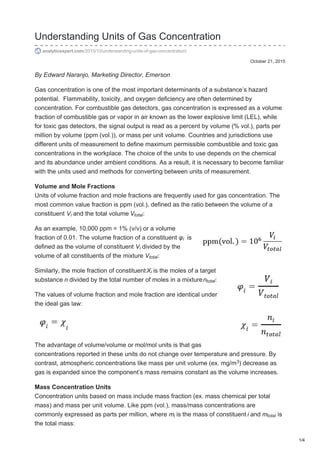
Understanding units of gas concentration
- 1. October 21, 2015 Understanding Units of Gas Concentration analyticexpert.com/2015/10/understanding-units-of-gas-concentration/ By Edward Naranjo, Marketing Director, Emerson Gas concentration is one of the most important determinants of a substance’s hazard potential. Flammability, toxicity, and oxygen deficiency are often determined by concentration. For combustible gas detectors, gas concentration is expressed as a volume fraction of combustible gas or vapor in air known as the lower explosive limit (LEL), while for toxic gas detectors, the signal output is read as a percent by volume (% vol.), parts per million by volume (ppm (vol.)), or mass per unit volume. Countries and jurisdictions use different units of measurement to define maximum permissible combustible and toxic gas concentrations in the workplace. The choice of the units to use depends on the chemical and its abundance under ambient conditions. As a result, it is necessary to become familiar with the units used and methods for converting between units of measurement. Volume and Mole Fractions Units of volume fraction and mole fractions are frequently used for gas concentration. The most common value fraction is ppm (vol.), defined as the ratio between the volume of a constituent V and the total volume V : As an example, 10,000 ppm = 1% (v/v) or a volume fraction of 0.01. The volume fraction of a constituent φ is defined as the volume of constituent V divided by the volume of all constituents of the mixture V : Similarly, the mole fraction of constituentX is the moles of a target substance n divided by the total number of moles in a mixturen : The values of volume fraction and mole fraction are identical under the ideal gas law: The advantage of volume/volume or mol/mol units is that gas concentrations reported in these units do not change over temperature and pressure. By contrast, atmospheric concentrations like mass per unit volume (ex. mg/m ) decrease as gas is expanded since the component’s mass remains constant as the volume increases. Mass Concentration Units Concentration units based on mass include mass fraction (ex. mass chemical per total mass) and mass per unit volume. Like ppm (vol.), mass/mass concentrations are commonly expressed as parts per million, where m is the mass of constituent i and m is the total mass: i total i i total i total 3 i total 1/4
- 2. Note: Where a gas concentration is expressed simply as ppm, it is unclear whether a volume or mass basis is intended. In the atmosphere, it is common to express concentrations of mass/volume air like milligrams per meter cubed (mg/m ). Thus, the United States’ National Institute for Occupational Safety and Health (NIOSH) Pocket Guide for Chemical Hazards reports worker exposure limits in ppm (vol.) and mg/m . To convert from ppm (vol.) to mg/m , it is assumed the ideal gas law applies under standard temperature and pressure where MW equals molecular weight: Note that at standard conditions (p = 760 mmHg, T = 273°K), one mole of any pure gas occupies a volume of 22.4 L. Another useful formula is one that converts from units of ppm (vol.) to ppm (m) at 760 mmHg and 25°C: For convenience, NIOSH recommended exposure limits (REL’s) for several toxic gases are shown in Table 1 below. 3 3 3 2/4
- 3. Table 2 shows the LEL’s of several combustible gases in ppm (vol.), ppm(m), and volume fraction. Last, conversion units for common industrial gases are illustrated in Table 3. Situations Where Unit Conversions May Be Useful It is tempting to think that converting units of measurement is hardly necessary. After all, in most countries, combustible gas concentrations are measured either in volume fractions or its derivatives, while toxic gas exposure limits are established in ppm (vol.) or mass volume units. Yet one cannot gauge a gas’ hazard potential without comparing attributes in a common plane. Consider that several toxic gases like ammonia and hydrogen sulfide are combustible. The graph in Figure 1 below showing gas concentration in ppm (vol.) gives a sense of toxic and combustible limits in relationship to one another. Similarly, most hydrocarbons are harmful long before they are at combustible concentrations. As shown in Figure 2 below, the IDLH is often at approximately 10% LEL. Based on those results, an analysis of hydrocarbon toxicity recommended that alarm levels be set at 10% LEL to protect workers from hydrocarbon narcosis (Gardner 2012). References ISO 10156, Determination of Fire Potential and Oxidizing Ability for the Selection of Cylinder Valve Outlets. 2010. Geneva, Switzerland: ISO. 3/4
- 4. Gardner, R. 2012. Use of Reciprocal Calculation Procedures for Setting Workplace Emergency Action Levels for Hydrocarbon Mixtures and their Relationship to Lower Explosive Limits. Ann. Occup. Hyg. 56 (3): 326–339. 4/4
